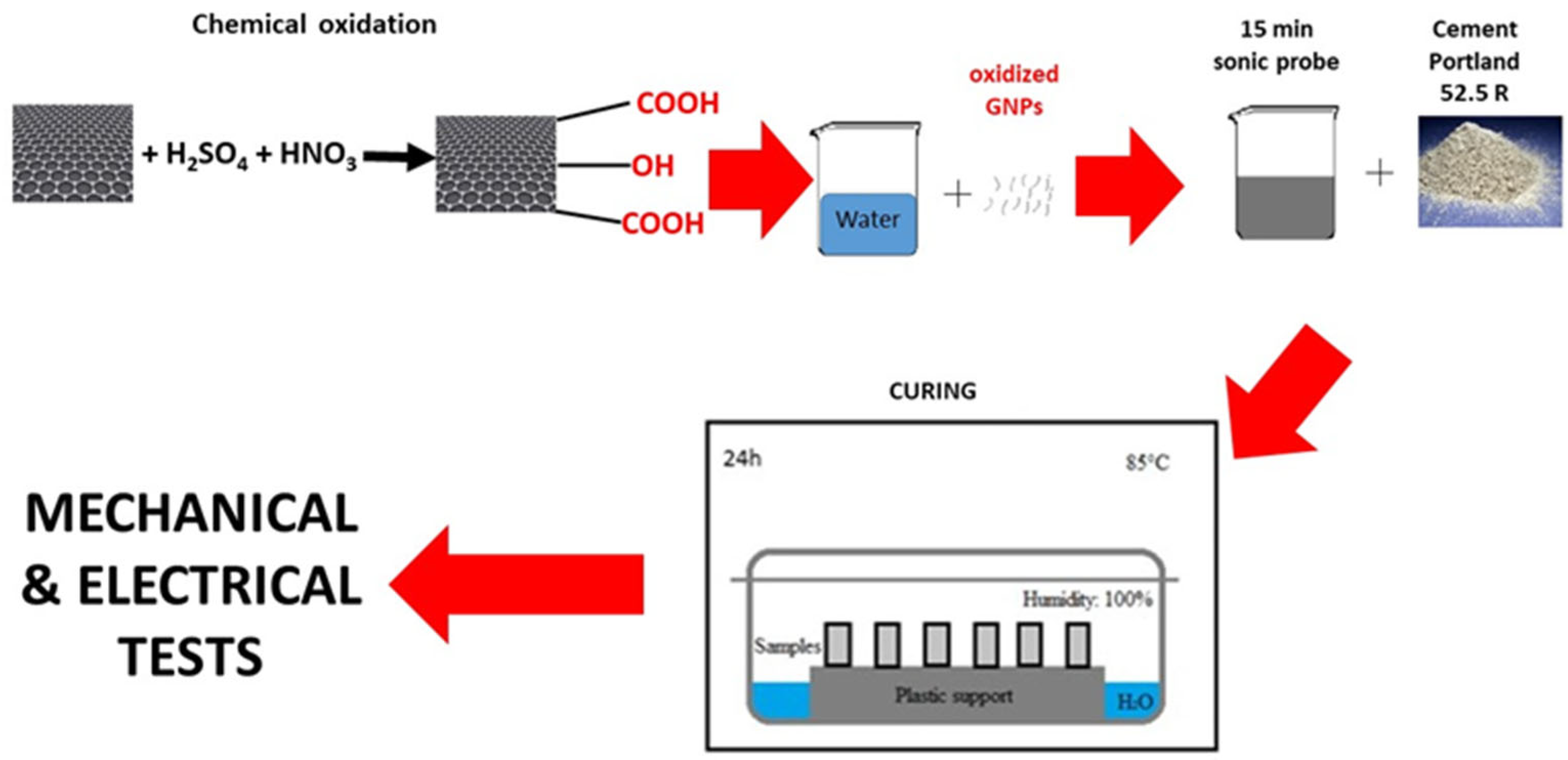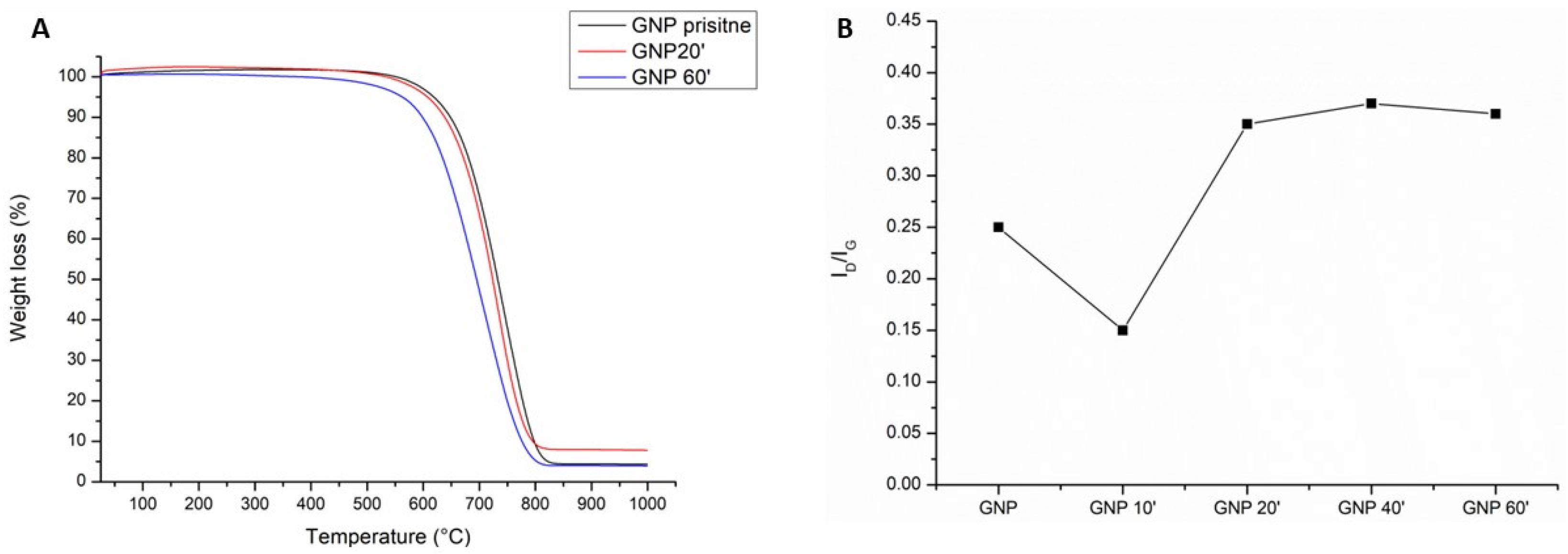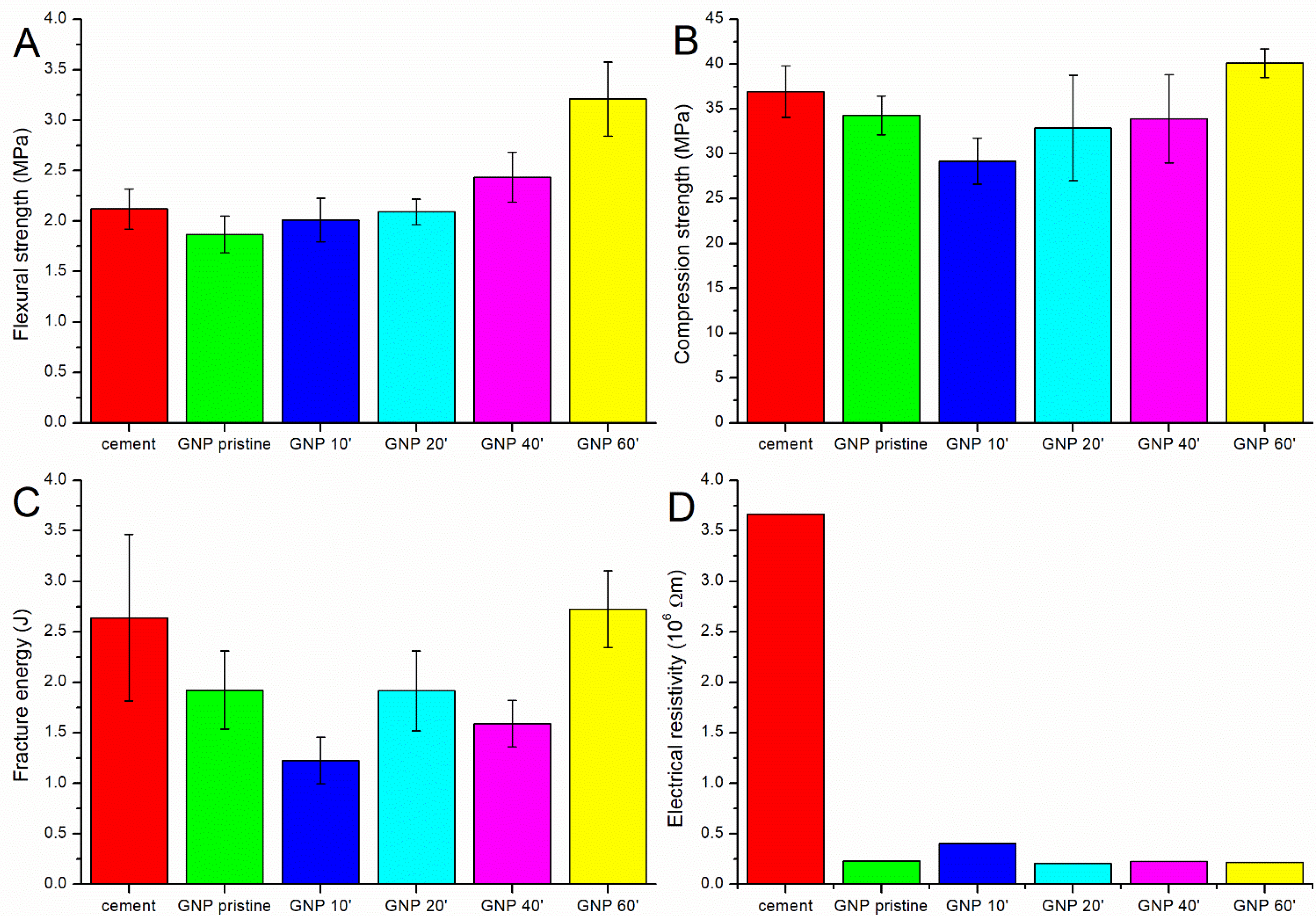Cement-Based Composites Containing Oxidized Graphene Nanoplatelets: Effects on the Mechanical and Electrical Properties
Abstract
1. Introduction
2. Materials and Methods
3. Experimental Section
4. Results and Discussion
5. Conclusions
Supplementary Materials
Author Contributions
Funding
Data Availability Statement
Conflicts of Interest
References
- Novoselov, K.S.; Geim, A.K.; Morozov, S.V.; Jiang, D.; Zhang, Y.; Dubonos, S.V.; Grigorieva, I.V.; Firsov, A.A. Electric field effect in atomically thin carbon films. Science 2004, 306, 666–669. [Google Scholar] [CrossRef] [PubMed]
- Geim, A.K.; Novoselov, K.S. The Rise of Graphene. Nat. Mater. 2007, 6, 183. [Google Scholar] [CrossRef] [PubMed]
- Castro Neto, A.H.; Guinea, F.; Peres, N.M.R.; Novoselov, K.S.; Geim, A.K. The Electronic Properties of Graphene. Rev. Mod. Phys. 2009, 81, 109–162. [Google Scholar] [CrossRef]
- Balandin, A.A. Thermal Properties of Graphene and Nanostructured Carbon Materials. Nat. Mater. 2011, 10, 569. [Google Scholar] [CrossRef] [PubMed]
- Lee, C.; Wei, X.; Kysar, J.W.; Hone, J. Measurement of the Elastic Properties and Intrinsic Strength of Monolayer Graphene. Science 2008, 321, 385. [Google Scholar] [CrossRef]
- Jun, Y.; Habibpour, S.; Hamidinejad, M.; Park, M.G.; Ahn, W.; Yu, A.; Park, C.B. Enhanced Electrical and Mechanical Properties of Graphene Nano-Ribbon/Thermoplastic Polyurethane Composites. Carbon 2021, 174, 305–316. [Google Scholar] [CrossRef]
- Danial, W.H.; Abdul Majid, Z. Recent Advances on the Enhanced Thermal Conductivity of Graphene Nanoplatelets Composites: A Short Review. Carbon Lett. 2022, 32, 1411–1424. [Google Scholar] [CrossRef]
- Lu, Z.; Hou, D.; Meng, L.; Sun, G.; Lu, C.; Li, Z. Mechanism of Cement Paste Reinforced by Graphene Oxide/Carbon Nanotubes Composites with Enhanced Mechanical Properties. RSC Adv. 2015, 5, 100598–100605. [Google Scholar] [CrossRef]
- Ju, J.-M.; Wang, G.; Sim, K.-H. Facile synthesis of graphene reinforced Al matrix composites with improved dispersion of graphene and enhanced mechanical properties. J. Alloy. Compd. 2017, 704, 585–592. [Google Scholar] [CrossRef]
- Sood, A.K.; Lund, I.; Puri, Y.R.; Efstathiadis, H.; Haldar, P.; Dhar, N.K.; Lewis, J.; Dubey, M.; Zakar, E.; Wijewarnasuriya, P.; et al. Review of Graphene Technology and Its Applications for Electronic Devices. In Graphene—New Trends and Developments; Ebrahimi, F., Ed.; InTech: London, UK, 2015; ISBN 978-953-51-2220-3. [Google Scholar]
- Sun, Y.; Sun, M.; Xie, D. 5-Graphene Electronic Devices. In Graphene; Zhu, H., Xu, Z., Xie, D., Fang, Y., Eds.; Academic Press: Cambridge, MA, USA, 2018; pp. 103–155. ISBN 978-0-12-812651-6. [Google Scholar]
- Yang, H.; Cui, H.; Tang, W.; Li, Z.; Han, N.; Xing, F. A Critical Review on Research Progress of Graphene/Cement Based Composites. Compos. Part Appl. Sci. Manuf. 2017, 102, 273–296. [Google Scholar] [CrossRef]
- Schulte, J.; Jiang, Z.; Sevim, O.; Ozbulut, O.E. Chapter 4—Graphene-Reinforced Cement Composites for Smart Infrastructure Systems. In The Rise of Smart Cities; Alavi, A.H., Feng, M.Q., Jiao, P., Sharif-Khodaei, Z., Eds.; Butterworth-Heinemann: Oxford, UK, 2022; pp. 79–114. ISBN 978-0-12-817784-6. [Google Scholar]
- Krystek, M.; Ciesielski, A.; Samorì, P. Graphene-Based Cementitious Composites: Toward Next-Generation Construction Technologies. Adv. Funct. Mater. 2021, 31, 2101887. [Google Scholar] [CrossRef]
- Jiang, Z.; Sevim, O.; Ozbulut, O.E. Mechanical Properties of Graphene Nanoplatelets-Reinforced Concrete Prepared with Different Dispersion Techniques. Constr. Build. Mater. 2021, 303, 124472. [Google Scholar] [CrossRef]
- Mu, S.; Yue, J.; Wang, Y.; Feng, C. Electrical, Piezoresistive and Electromagnetic Properties of Graphene Reinforced Cement Composites: A Review. Nanomaterials 2021, 11, 3220. [Google Scholar] [CrossRef]
- Bai, S.; Jiang, L.; Xu, N.; Jin, M.; Jiang, S. Enhancement of Mechanical and Electrical Properties of Graphene/Cement Composite Due to Improved Dispersion of Graphene by Addition of Silica Fume. Constr. Build. Mater. 2018, 164, 433–441. [Google Scholar] [CrossRef]
- Korayem, A.H.; Tourani, N.; Zakertabrizi, M.; Sabziparvar, A.M.; Duan, W.H. A Review of Dispersion of Nanoparticles in Cementitious Matrices: Nanoparticle Geometry Perspective. Constr. Build. Mater. 2017, 153, 346–357. [Google Scholar] [CrossRef]
- Freitas, R.R.Q.; Rivelino, R.; de Brio Mota, F.; de Castilho, C.M.C. DFT Studies of the Interactions of a Graphene Layer with Small Water Aggregates. J. Phys. Chem. A 2011, 115, 12348–12356. [Google Scholar] [CrossRef]
- Mypati, S.; Sellathurai, A.; Kontopoulou, M.; Docoslis, A.; Barz, D.P.J. High Concentration Graphene Nanoplatelet Dispersions in Water Stabilized by Graphene Oxide. Carbon 2021, 174, 581–593. [Google Scholar] [CrossRef]
- Tao, J.; Wang, X.; Wang, Z.; Zeng, Q. Graphene Nanoplatelets as an Effective Additive to Tune the Microstructures and Piezoresistive Properties of Cement-Based Composites. Constr. Build. Mater. 2019, 209, 665–678. [Google Scholar] [CrossRef]
- Murali, M.; Alaloul, W.S.; Mohammed, B.S.; Musarat, M.A.; Salaheen, M.A.; Al-Sabaeei, A.M.; Isyaka, A. Utilizing Graphene Oxide in Cementitious Composites: A Systematic Review. Case Stud. Constr. Mater. 2022, 17, e01359. [Google Scholar] [CrossRef]
- Suo, Y.; Guo, R.; Xia, H.; Yang, Y.; Zhou, B.; Zhao, Z. A Review of Graphene Oxide/Cement Composites: Performance, Functionality, Mechanisms, and Prospects. J. Build. Eng. 2022, 53, 104502. [Google Scholar] [CrossRef]
- Lavagna, L.; Massella, D.; Priola, E.; Pavese, M. Relationship between Oxygen Content of Graphene and Mechanical Properties of Cement-Based Composites. Cem. Concr. Compos. 2021, 115, 103851. [Google Scholar] [CrossRef]
- Li, X.; Korayem, A.H.; Li, C.; Liu, Y.; He, H.; Sanjayan, J.G.; Duan, W.H. Incorporation of Graphene Oxide and Silica Fume into Cement Paste: A Study of Dispersion and Compressive Strength. Constr. Build. Mater. 2016, 123, 327–335. [Google Scholar] [CrossRef]
- Peng, C.; Zhang, X. Chemical Functionalization of Graphene Nanoplatelets with Hydroxyl, Amino, and Carboxylic Terminal Groups. Chemistry 2021, 3, 873–888. [Google Scholar] [CrossRef]
- Abrishami, M.E.; Zahabi, V. Reinforcing Graphene Oxide/Cement Composite with NH2 Functionalizing Group. Bull. Mater. Sci. 2016, 39, 1073–1078. [Google Scholar] [CrossRef]
- Lavagna, L.; Nisticò, R.; Musso, S.; Pavese, M. Functionalization as a Way to Enhance Dispersion of Carbon Nanotubes in Matrices: A Review. Mater. Today Chem. 2021, 20, 100477. [Google Scholar] [CrossRef]
- Sadiq, M.M.; Soroushian, P.; Bakker, M.G.; Balachandra, A.M. Ultra-High-Performance Cementitious Composites with Enhanced Mechanical and Durability Characteristics. SN Appl. Sci. 2021, 3, 676. [Google Scholar] [CrossRef]
- Giorcelli, M.; Bartoli, M. Development of Coffee Biochar Filler for the Production of Electrical Conductive Reinforced Plastic. Polymers 2019, 11, 1916. [Google Scholar] [CrossRef]
- Nisticò, R.; Lavagna, L.; Boot, E.A.; Ivanchenko, P.; Lorusso, M.; Bosia, F.; Pugno, N.M.; D’Angelo, D.; Pavese, M. Improving Rubber Concrete Strength and Toughness by Plasma-induced End-of-life Tire Rubber Surface Modification. Plasma Process. Polym. 2021, 18, 2100081. [Google Scholar] [CrossRef]
- Lavagna, L.; Massella, D.; Pavese, M. Preparation of Hierarchical Material by Chemical Grafting of Carbon Nanotubes onto Carbon Fibers. Diam. Relat. Mater. 2017, 80, 118–124. [Google Scholar] [CrossRef]
- Dang, N.; Tao, J.; Zeng, Q.; Zhao, W. May the Piezoresistivity of GNP-Modified Cement Mortar Be Related to Its Fractal Structure? Fractal Fract. 2021, 5, 148. [Google Scholar] [CrossRef]
- Lavagna, L.; Musso, S.; Ferro, G.; Pavese, M. Cement-Based Composites Containing Functionalized Carbon Fibers. Cem. Concr. Compos. 2018, 88, 165–171. [Google Scholar] [CrossRef]
- Ferro, G.; Tulliani, J.-M.; Musso, S. Carbon Nanotubes Cement Composites. Frat. Integrità Strutt. 2016, 5, 34–44. [Google Scholar] [CrossRef]
- Coppola, L.; Buoso, A.; Corazza, F. Electrical Properties of Carbon Nanotubes Cement Composites for Monitoring Stress Conditions in Concrete Structures. Appl. Mech. Mater. 2011, 82, 118–123. [Google Scholar] [CrossRef]
- Qi, G.; Wang, Q.; Zhang, R.; Guo, Z.; Zhan, D.; Liu, S. Effect of RGO/GNP on the Electrical Conductivity and Piezoresistance of Cement-Based Composite Subjected to Dynamic Loading. Constr. Build. Mater. 2023, 368, 130340. [Google Scholar] [CrossRef]
- Tuinstra, F.; Koenig, J.L. Raman Spectrum of Graphite. J. Chem. Phys. 1970, 53, 1126–1130. [Google Scholar] [CrossRef]
- Hou, P.-X.; Liu, C.; Cheng, H.-M. Purification of Carbon Nanotubes. Carbon 2008, 46, 2003–2025. [Google Scholar] [CrossRef]
- Ambrosi, A.; Chua, C.K.; Khezri, B.; Sofer, Z.; Webster, R.D.; Pumera, M. Chemically Reduced Graphene Contains Inherent Metallic Impurities Present in Parent Natural and Synthetic Graphite. Proc. Natl. Acad. Sci. USA 2012, 109, 12899–12904. [Google Scholar] [CrossRef]
- Zheng, Q.; Han, B.; Cui, X.; Yu, X.; Ou, J. Graphene-Engineered Cementitious Composites: Small Makes a Big Impact. Nanomater. Nanotechnol. 2017, 7, 184798041774230. [Google Scholar] [CrossRef]
- Wang, L.; Aslani, F. Mechanical Properties, Electrical Resistivity and Piezoresistivity of Carbon Fibre-Based Self-Sensing Cementitious Composites. Ceram. Int. 2021, 47, 7864–7879. [Google Scholar] [CrossRef]
- Bobylev, S.V.; Sheinerman, A.G. Effect of Crack Bridging on the Toughening of Ceramic/Graphene Composites. Rev. Adv. Mater. Sci. 2018, 57, 54–62. [Google Scholar] [CrossRef]
- Lavagna, L.; Bartoli, M.; Suarez-Riera, D.; Cagliero, D.; Musso, S.; Pavese, M. Oxidation of Carbon Nanotubes for Improving the Mechanical and Electrical Properties of Oil-Well Cement-Based Composites. ACS Appl. Nano Mater. 2022, 5, 6671–6678. [Google Scholar] [CrossRef]




| Oxide | (wt.%) | Phase | (wt.%) |
|---|---|---|---|
| SiO2 | 20.0 | C3S | 49.1 |
| CaO | 63.2 | C2S | 19.7 |
| Al2O3 | 4.1 | C3A | 7.9 |
| Fe2O3 | 1.9 | C4AF | 5.2 |
| MgO | 4.2 | ||
| SO3 | 3.4 | ||
| Na2O | 0.003 | ||
| K2O | 0.001 | ||
| Loss on ignition | 0.8 |
| Sample Name | Water (g) | Cement (g) | GNP (g) |
|---|---|---|---|
| Cement | 95.25 | 190.5 | / |
| GNP | 95.25 | 190.5 | 0.19 |
| GNP 10’ | 95.25 | 190.5 | 0.19 |
| GNP 20’ | 95.25 | 190.5 | 0.19 |
| GNP 40’ | 95.25 | 190.5 | 0.19 |
| GNP 60’ | 95.25 | 190.5 | 0.19 |
| Sample Name | Time (min) | Density (g/cm3) | Flexural Strength (MPa) | Fracture Energy (J) | Compression Strength (MPa) | Electrical Resistivity (106 Ω m) |
|---|---|---|---|---|---|---|
| Cement | / | 1.63 | 2.1 ± 0.2 | 2.6 ± 0.8 | 36.9 ± 2.9 | 3.6 |
| GNP | / | 1.62 | 2.2 ± 0.2 | 1.9 ± 0.4 | 34.3 ± 2.2 | 0.2 |
| GNP 10’ | 10 | 1.70 | 1.8 ± 0.2 | 1.2 ± 0.2 | 29.2 ± 2.6 | 0.4 |
| GNP 20’ | 20 | 1.76 | 2.0 ± 0.1 | 1.9 ± 0.4 | 32.9 ± 5.9 | 0.2 |
| GNP 40’ | 40 | 1.73 | 2.5 ± 0.2 | 1.6 ± 0.2 | 33.9 ± 4.9 | 0.2 |
| GNP 60’ | 60 | 1.86 | 3.3 ± 0.3 | 2.7 ± 0.3 | 40.1 ± 2.5 | 0.2 |
Disclaimer/Publisher’s Note: The statements, opinions and data contained in all publications are solely those of the individual author(s) and contributor(s) and not of MDPI and/or the editor(s). MDPI and/or the editor(s) disclaim responsibility for any injury to people or property resulting from any ideas, methods, instructions or products referred to in the content. |
© 2023 by the authors. Licensee MDPI, Basel, Switzerland. This article is an open access article distributed under the terms and conditions of the Creative Commons Attribution (CC BY) license (https://creativecommons.org/licenses/by/4.0/).
Share and Cite
Lavagna, L.; Santagati, A.; Bartoli, M.; Suarez-Riera, D.; Pavese, M. Cement-Based Composites Containing Oxidized Graphene Nanoplatelets: Effects on the Mechanical and Electrical Properties. Nanomaterials 2023, 13, 901. https://doi.org/10.3390/nano13050901
Lavagna L, Santagati A, Bartoli M, Suarez-Riera D, Pavese M. Cement-Based Composites Containing Oxidized Graphene Nanoplatelets: Effects on the Mechanical and Electrical Properties. Nanomaterials. 2023; 13(5):901. https://doi.org/10.3390/nano13050901
Chicago/Turabian StyleLavagna, Luca, Andrea Santagati, Mattia Bartoli, Daniel Suarez-Riera, and Matteo Pavese. 2023. "Cement-Based Composites Containing Oxidized Graphene Nanoplatelets: Effects on the Mechanical and Electrical Properties" Nanomaterials 13, no. 5: 901. https://doi.org/10.3390/nano13050901
APA StyleLavagna, L., Santagati, A., Bartoli, M., Suarez-Riera, D., & Pavese, M. (2023). Cement-Based Composites Containing Oxidized Graphene Nanoplatelets: Effects on the Mechanical and Electrical Properties. Nanomaterials, 13(5), 901. https://doi.org/10.3390/nano13050901











